Touvelle State Recreation Site Acorn Granary

Touvelle Granary Tree — at a distance
Many Oregonians are familiar with Acorn Woodpeckers, which are easily recognizable by their clownish black and white faces, red heads, and noisy calls. They live in social groups and have an interesting mating system that involves multiple males and females sharing one nesting cavity and raising chicks together.
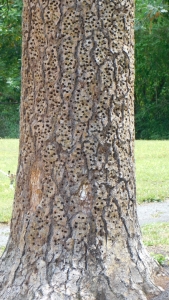
Touvelle Granary Tree — much closer
Acorn Woodpeckers also share their food storage systems, called granaries. According to Cornell’s Bird Academy, each woodpecker “…group works together to maintain and defend its acorn collection…reused over generations to store the winter food supply.” Granaries are not rare, but the Touvelle State Recreation Site, which runs adjacent to the Rogue River east of White City, houses an especially impressive one, with thousands of acorns inserted from the top of the tree to the bottom. It is easily found near the parking lot. Drive to the far end of the lot and face the restrooms located at the top of the hill that edges the lot. The tree — a dead trunk devoid of limbs — is located to the left of the restrooms, not far from curb.
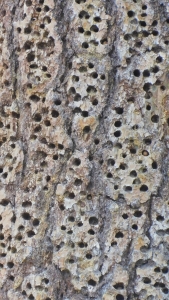
Touvelle Granary close-up
Although not odd, the rest of the Recreation Site is worth a visit. There is an easily walkable nature trail that winds along the side of the river, and then loops through meadows and a seasonal wetland. It is a good place to look for winter birds, swallows in the summer, and the ubiquitous woodpeckers. A nice place to picnic, there are picnic tables and benches. It is quiet during weekdays. A $5.00 entrance fee is charged.
Manor resident readers can find an even closer granary tree. This tree, located at the side (library) entrance into the Manor Building, has become a beloved natural icon, and a spirited and successful protest was launched when consideration was being given to removing the tree. Granted, the tree is dead and several limbs have been removed or fallen off. Its days are numbered so locals should enjoy it along with the Acorn Woodpeckers that may frequently be seen on the tree. This more humble tree also is pictured below. — Anne

Cross section, Bear Creek Park granary tree
I don’t know that I consider the tree more humble —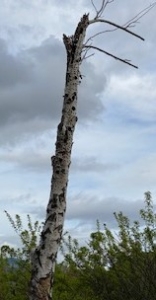 dilapidated, perhaps. The RVM granary tree is shown at right. To provide some detailed anatomy, the other pictures (at left and below) show two views of a section cut from a granary tree that was felled in Bear Creek Park. Real snacks for acorn-eaters. Who are the other local consumers? Squirrels and other rodents, although they might have trouble getting around the defenses of a “social group” (a.k.a. militia) of woodpeckers. Turkeys like acorns, but only the ones that fall in the streets where the cars crush the shells. And bears. Do woodpeckers attract bears? I don’t know, but if I come upon a tree that has big scratch marks as well as little holes containing acorns, I will probably redirect my nature study to some other location. — Bob
dilapidated, perhaps. The RVM granary tree is shown at right. To provide some detailed anatomy, the other pictures (at left and below) show two views of a section cut from a granary tree that was felled in Bear Creek Park. Real snacks for acorn-eaters. Who are the other local consumers? Squirrels and other rodents, although they might have trouble getting around the defenses of a “social group” (a.k.a. militia) of woodpeckers. Turkeys like acorns, but only the ones that fall in the streets where the cars crush the shells. And bears. Do woodpeckers attract bears? I don’t know, but if I come upon a tree that has big scratch marks as well as little holes containing acorns, I will probably redirect my nature study to some other location. — Bob
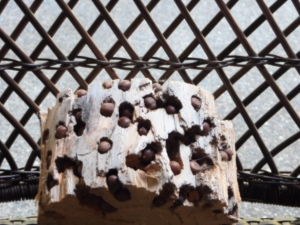
Side view, section of Bear Creek Park granary tree
A ghost town worthy of it’s title: Golden

We are discovering that the OAL (Oddity Attraction Level) may be enhanced by a good meal along the way. So, visitors are encouraged to stop at the historic Wolf Creek Inn for a casual and tasty repast. Nine rooms, appropriately decorated, also are available. Built in 1883 for travelers following the Applegate Trail, the inn remains open for I-5 motorists today. Alas, meals, room, and bath no longer are available for 75 cents, but the ambiance is much more interesting than the usual chain restaurants found off of interstate highways. The inn now is managed by the Oregon State Parks as a State Heritage Site. The grounds are open to the public. For more information: http://wolfcreekinn.com.
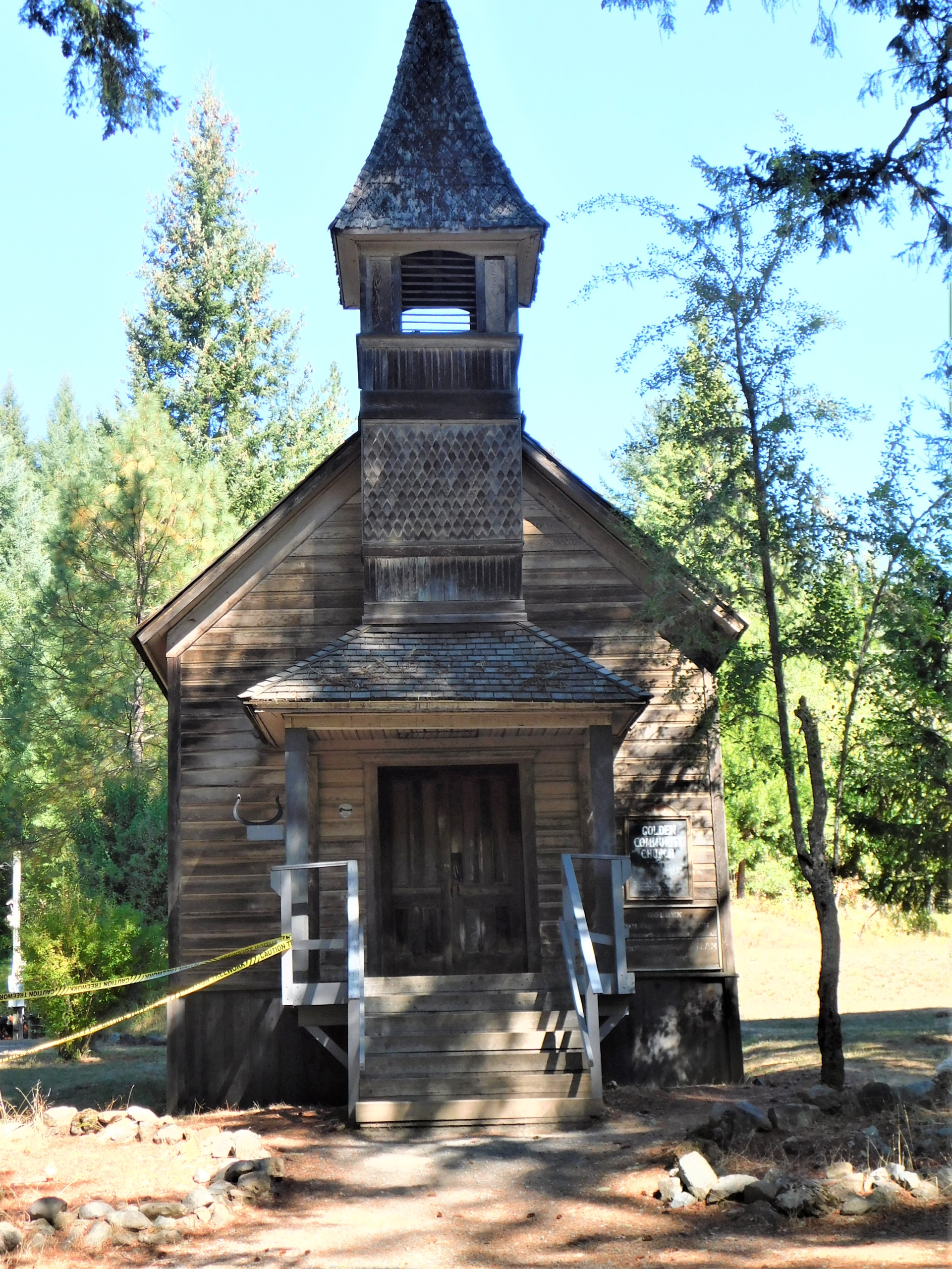
The real goal for our trip was to find a ghost town that was more impressive than Buncom. Located twenty miles north of Grants Pass, and easily found east of I-5 and the Wolf Creek Inn exit, Golden Historic District is an Oregon State Heritage Site. Located near Coyote Creek, the town originally was settled in the 1840s by aspiring gold miners. It was abandoned by the peripatetic miners and then taken over temporarily by Chinese miners. As was true in many other places, the Chinese were then expelled by the original settlers. By about 1885, a hydraulic mine was in place, followed by a church, general store, and carriage house, all of which remain today. The buildings are well preserved and the church is especially attractive. When combined with ease of access and lunch at the Wolf Creek Inn, the OAL for Golden is at least at 9 (out of 10). Kudos also are due to local groups who gradually have been restoring the mining pits to functioning wetlands, which now even house beavers.
Anne
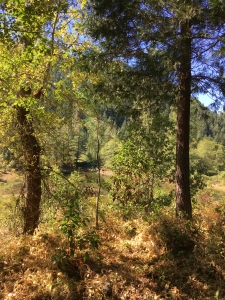
View of recovering wetlands at Golden
Yes, Golden definitely beats Buncom in the ghost-town sweepstakes — more buildings, older, more accessible, farther off the grid, a little more visibly decayed. Anne’s 9/10 score would be a little high for either attraction alone, but I agree is justified if we roll inn and town into one OAL score — (for Buncom, a 2 would be generous). I really can’t go much higher the town alone; it is maintained and protected and if there are people intimately involved, they get in the way of the ghosts.
And speaking of which, if your taste in oddities runs to the invisible and intangible (i.e. supernatural), you might do worse than to linger longer (perhaps overnight) at the Wolf Creek Inn. Multiple sources (see below) attest to haunting by ghosts of celebrities, children, pioneers, and other THINGS. To sample a few:
https://the-line-up.com/wolf-creek-inn
https://traveloregon.com/things-to-do/trip-ideas/favorite-trips/haunted-tales-wolf-creek-inn/
https://www.travelchannel.com/shows/ghost-adventures/photos/ghost-adventures-wolf-creek-inn
As we expand our bibliography (as yet in the planning stages) other references will be available. In the meantime, it’s a nice double-attraction for a day trip (only 50 freeway miles from Medford, with back roads available for part of the way). Click Here for map/directions
Bob 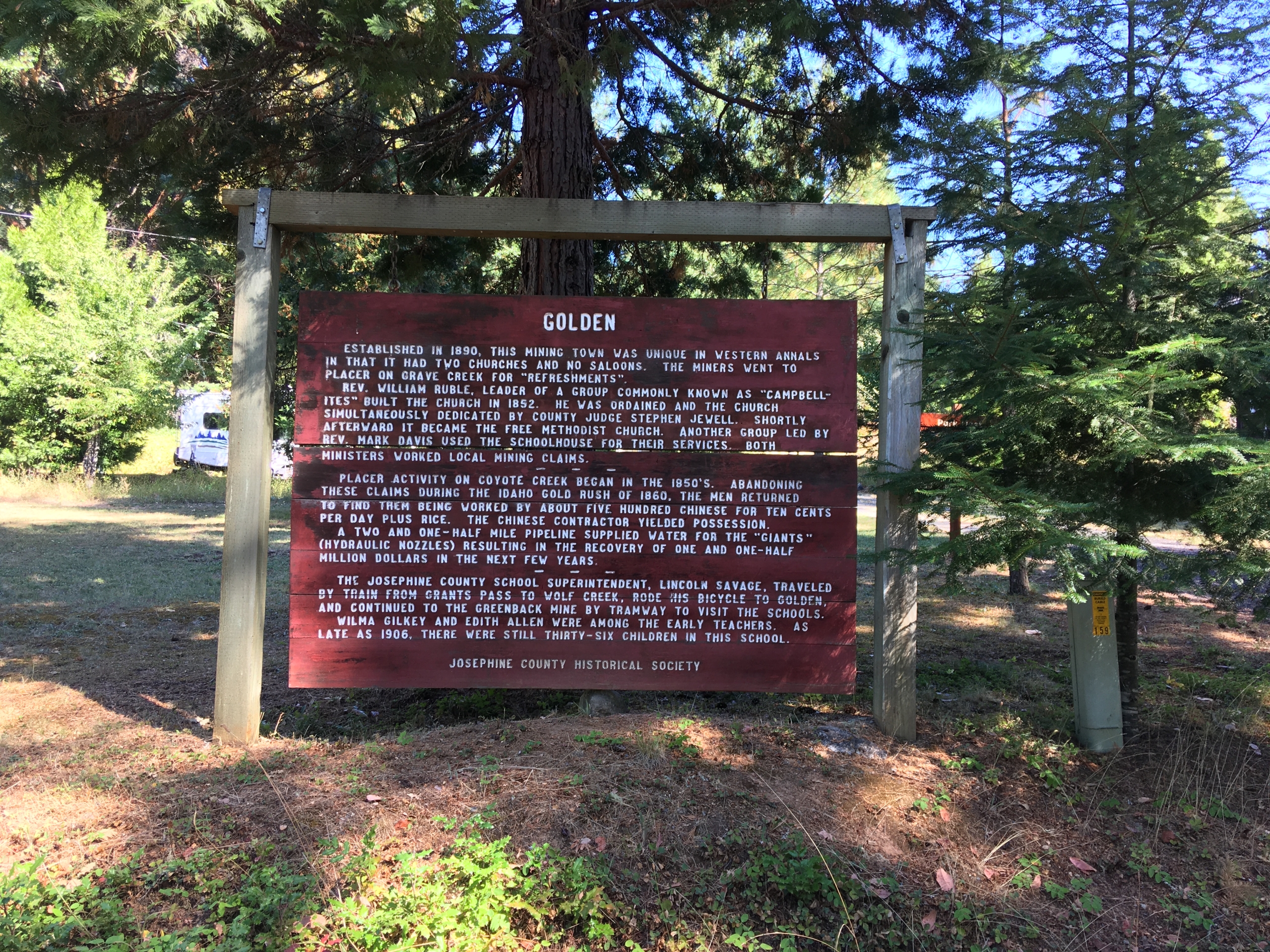
Fort Klamath: A flop
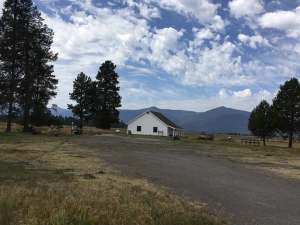
Fort Klamath from behind the fence
We thought Fort Klamath would be a good stop during a recent Klamath road trip. The fort was built during the Civil War era and served as a frontier Army outpost. A few buildings remain, as well as the graves of four Modoc Indians who were executed after the Modoc Indian War of 1872-73. Unfortunately, the fort was closed upon our arrival and the buildings could only be seen at a distance. Visitors should check in advance for current operating hours and days. Normally it is open from Memorial Day through September. There is no charge for admission.
Anne
Petric County Park and Wood River Wetland, Klamath County
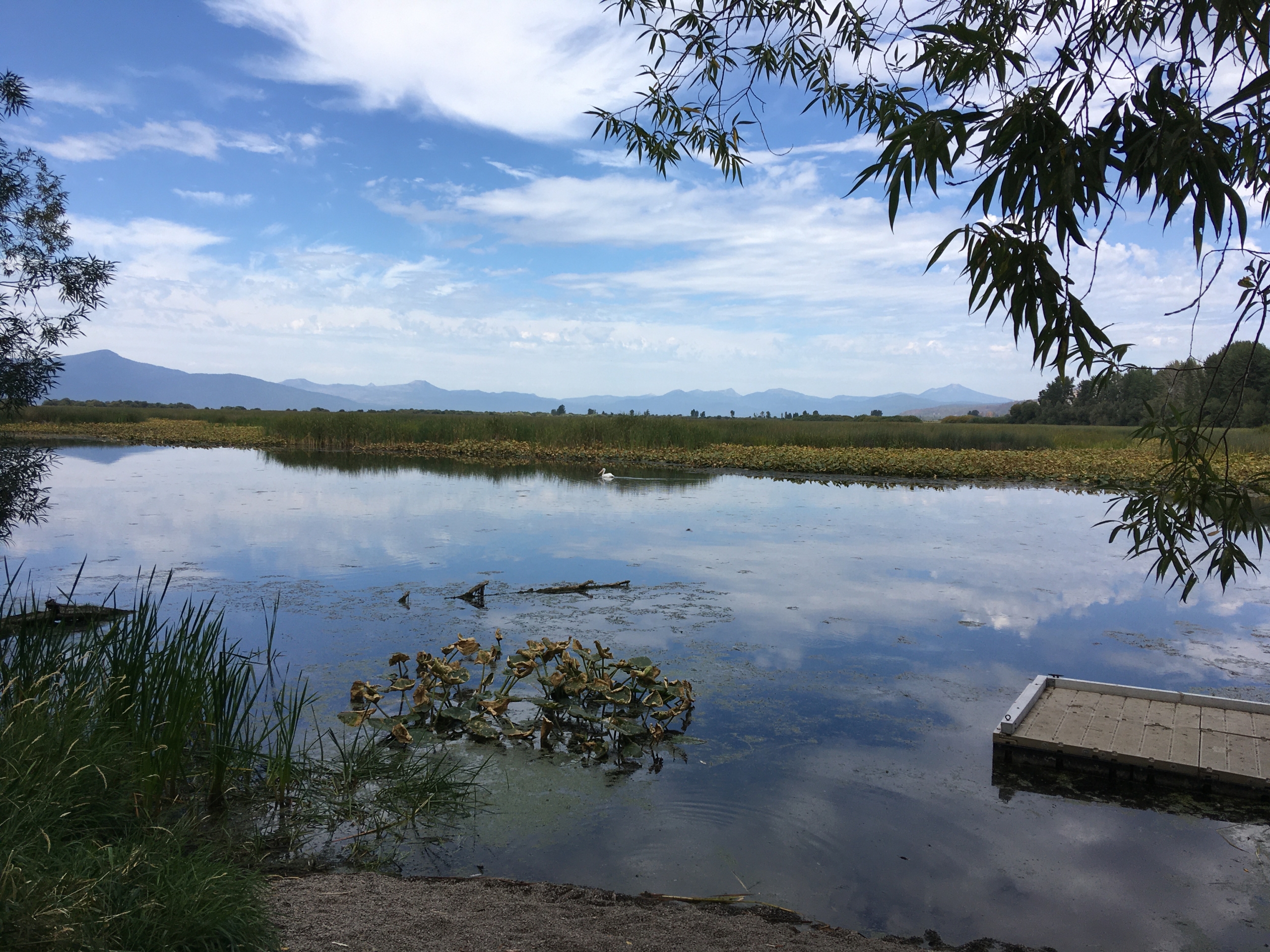
Wood River Wetland
Anyone interested in flora and fauna should stop at the Wood River Wetlands and Petric Park. The Wood River Wetland is part of a number of refuges and wetlands located in the Klamath Basin. It borders Agency Lake, abutting the north end of Klamath Lake. The day use area is flat, paved, and has several benches and viewing areas along the way, as well as a dock for launching canoes. There are interpretative signs for new visitors and restrooms for the needy. I’ve visited this location several times and always found it rewarding. Part of the Klamath Birding Trails, there are numerous species to be seen throughout the year, although access is limited in winter and spring if snow accumulates. Even non-birders could enjoy quiet contemplation looking out on the lake, towards the mountains surrounding the Klamath Basin, and the blowing aspens and willows.
 Nearby Petric Park is much smaller, but would be a pleasant place for a picnic and trout fishermen. There is good parking and a restroom. The number of bird species would be fewer than at the Wood River Wetland, but it still is worth a gander. Mostly, we were charmed by a family of otters gamboling nearby and easily seen. As seen in the photo below, a Great Blue Heron was totally unimpressed by signage prohibiting diving.
Nearby Petric Park is much smaller, but would be a pleasant place for a picnic and trout fishermen. There is good parking and a restroom. The number of bird species would be fewer than at the Wood River Wetland, but it still is worth a gander. Mostly, we were charmed by a family of otters gamboling nearby and easily seen. As seen in the photo below, a Great Blue Heron was totally unimpressed by signage prohibiting diving.
It is hard to justify either of these locations as being odd. One rationale might be that some of the visitors (not me!) could be considered odd…
Anne 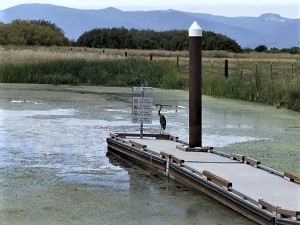
Darlingtonia State Natural Site – Florence, OR
Many years ago, I housed a Venus Flytrap. Despite periodically feeding it tiny scraps of hamburger, the trap kept growing closer and closer to the kitchen table, making meal times somewhat unnerving. Thus, an opportunity to see thousands of carnivorous plants in action was irresistible. According to the Oregon State Parks website, Darlingtonia State Natural Site “is the only Oregon State Park property dedicated to the protection of a single plant species…the plants it protects are the only carnivorous flora in the system.” For more information, go to http://stateparks.oregon.gov
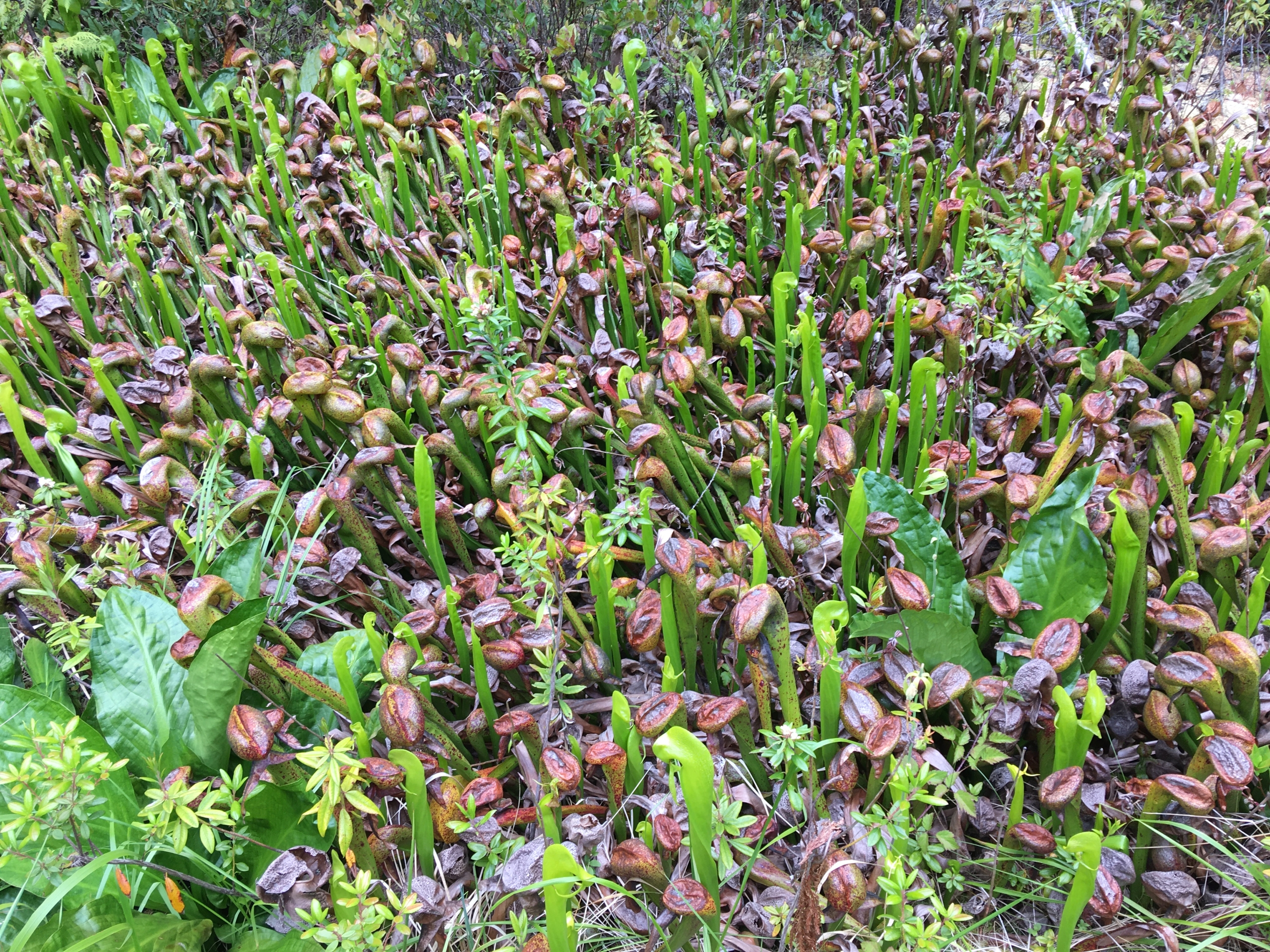 The plants are ten to twenty inches tall, with hooded leaves over hollow tubes. There are hidden openings housing nectar to attract insects. Insects have difficulty finding their way out, eventually falling to the bottom of the tube. They decompose and are absorbed by the plants. Fortunately, this process isn’t visible to visitors, who can enjoy the exotic appearance of the purple and red plants.
The plants are ten to twenty inches tall, with hooded leaves over hollow tubes. There are hidden openings housing nectar to attract insects. Insects have difficulty finding their way out, eventually falling to the bottom of the tube. They decompose and are absorbed by the plants. Fortunately, this process isn’t visible to visitors, who can enjoy the exotic appearance of the purple and red plants.
The small park, located north of Florence, contains boardwalks to traverse the park. Falling off the boardwalk is not likely to benefit either visitors or plants. The plants grow in boggy, serpentine soils, which also appear to be beneficial to ferns and colorful mosses. The area has dense stands of spruce, cedars, pines and rhododendron. We visited on an overcast day, which added an eerie feel to the environs. Anyone interested in unusual plants, especially carnivorous ones, would enjoy visiting the site.
Anne
The floristic commentary above hints at Anne’s status as a Master Gardener, although she is very modest about it because her training was in the CA Central Valley. However, she hit it exactly with the “eerie feel.” I kept looking around for doomed insects and listening for tiny bubbly shrieks as they fell into the digestive juices.
On the philosophical front, is this odd? You betcha. Just because it’s natural doesn’t make it ordinary. Nature green in fang and claw. The Garden of the Flesh-Eating Vegetation. Their popular nickname fits right in — Cobralily. It is a nice, if eerie, wayside stop, particularly well-suited for budding (ho ho) naturalists. Bob
To view or download a PDF of directions to the location, click here
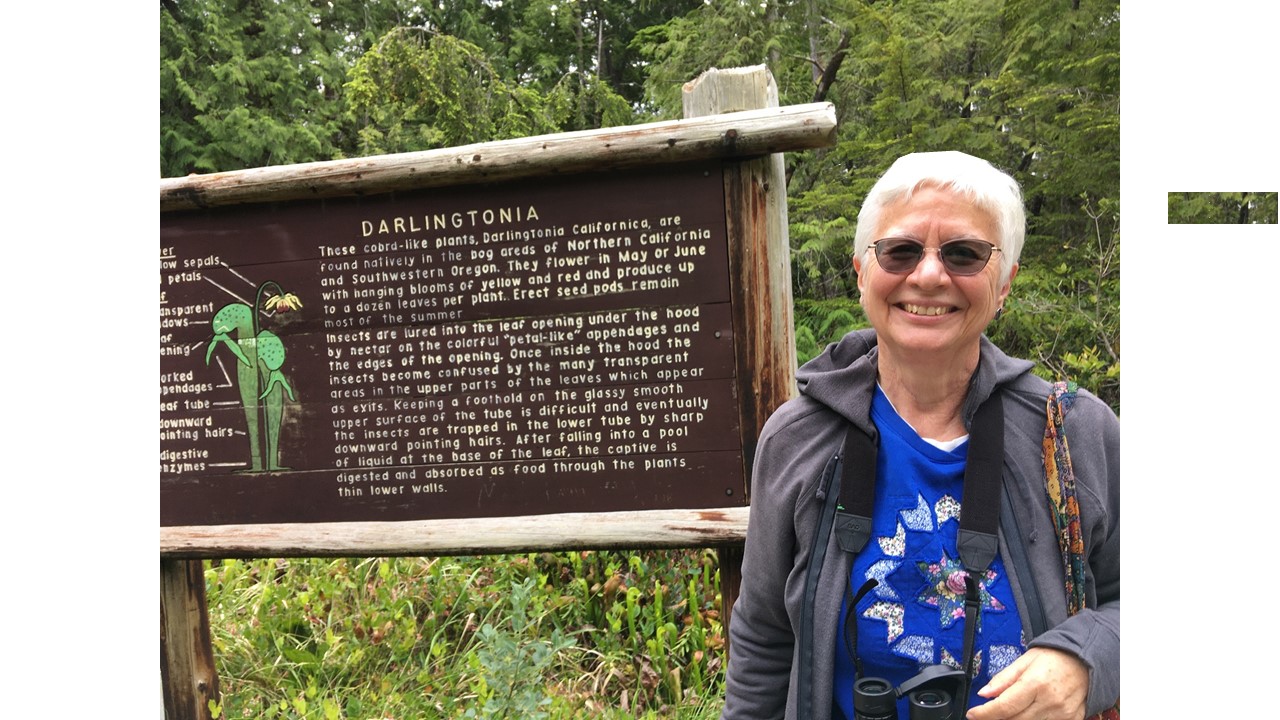

Exploding Whale Memorial Park – Florence, OR
“Call me Bob.” (Sorry, I couldn’t resist.) We began to recognize our proclivity for odd places after discovering the Exploding Whale Memorial Park in Florence. Noticing the entry sign near where we were staying, exploration was required. Strangely, there were no signs explaining the park’s name. When asked about the lack of explanation, a local resident simply said, “it’s not something we’re proud about.”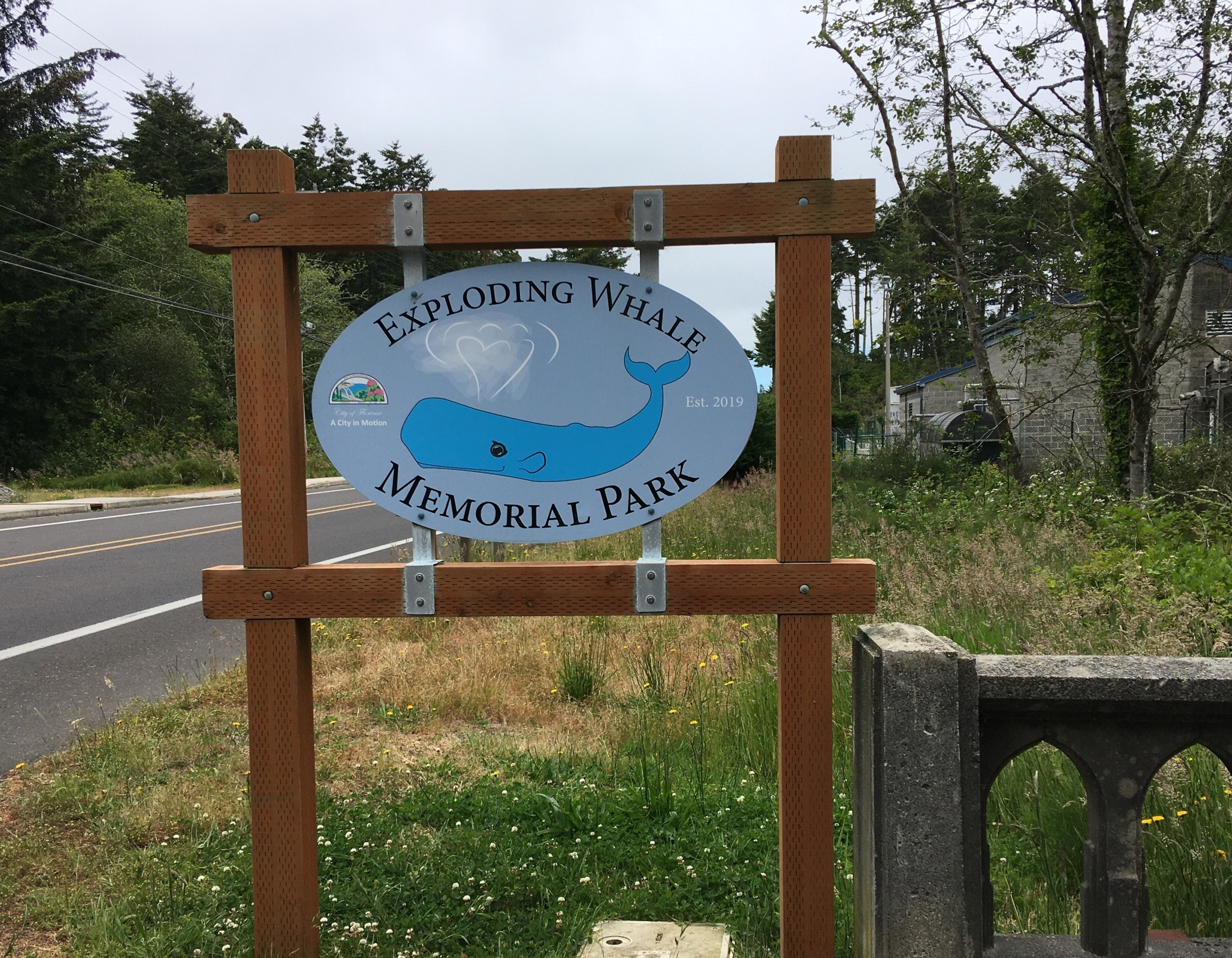
Google and YouTube came to rescue. In 1970, a 45′ whale carcass came ashore and debate arose about how to get rid of the eight-ton body. No one wanted to cut it up and bury it. Evidently towing it back out to sea wasn’t an option. Instead state highway officials decided to use a half-ton of dynamite to blow it up. The explosion succeeded far beyond expectations, with large chunks of whale landing on bystanders and even crushing a car. Fortunately, no one was seriously hurt. A hilarious, tongue-in-cheek video about the day’s events can be watched on YouTube at https://youtu.be/ax7kENH-a7s
Despite its grisly history, in 2020 Florencians decided to name the park after the incident, although they didn’t want to provide any information to curious visitors. Even without the intriguing title, the pleasant park is worth checking out. Located along the Siuslaw River, there are benches, short trails, and good views of the bridge crossing the river. It would make a good stop for a picnic or a hot cup of coffee.
Anne
The dedicated reader (do we have any other kind?) will have noticed that Anne tends to write the useful historical and descriptive material, while Bob mostly indulges in multidimensional speculation about the quantity and quality of oddness involved. So be it. In this case there is nothing obviously odd at the site other than the site and the sign — you might want to take along some device on which you can play the (highly entertaining) video linked above while standing at the actual epicenter.
The EWMP scores high on the uniqueness scale; if any other knucklehead has tried this method of whale disposal, they certainly haven’t publicized it. Dead whales happen, as does human stupidity, but this particular site combines two common occurrences into one spectacular oddity. If any of the perpetrators had suffered as a result, it definitely would have been in the running for a Darwin Award.
The drawback is that there isn’t really too much for the casual tourist, but for us, serendipity was part of the charm — we were both familiar with the exploding whale story, but had no idea of exactly where it happened until we came across the sign while driving down a beachside road in Florence. “OMG (or words to that effect)” we shrieked as we skidded to a halt. And the rest — or in fact almost all of it — is history. Bob
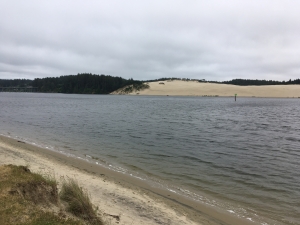
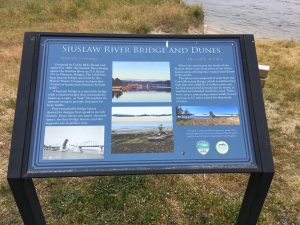
Tiniest park on Earth — In Talent, OR!
We were excited to read about the “tiniest park on Earth,” recently constructed in Talent. The park, yet to have a formal name, is part of the pollinator park located near central Talent. It can be accessed near the Valley View Road roundabout. Click here for directions and a local map.
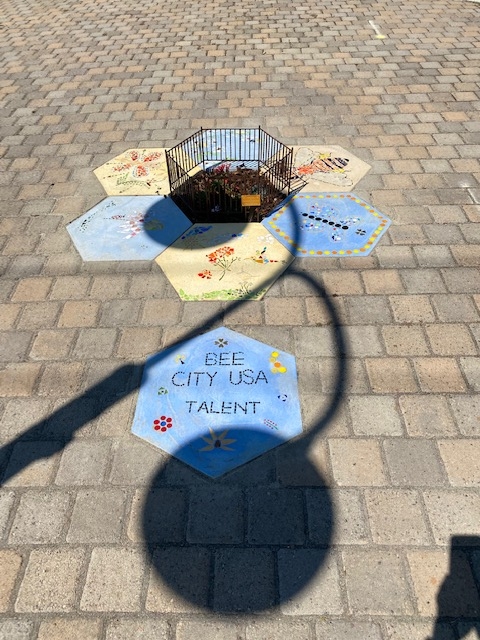
Talent was not defeated by the destructive Alameda fire and evidence of reconstruction is all around, not the least in their parks. Deciding to uproot Portland’s bragging rights about having the tiniest park in the world, the Talent Public Arts Committee presented the challenge to the community. The Talent Bee City and Talent Garden Club sprang into action. The new park is a tidy 374 square inches, clearly smaller than Portland’s Mill’s End Park, an expansive 452 square inches. To their credit, Portland accepted being reduced to second place gracefully.
The pollinator-friendly tiny park is surrounded by bee themed mosaics and has a notably short fence. Bob looked for homunculi bearing rakes and hoes without success. Admittedly, this may not be an awe inspiring park, but kudos to the pluck of the park’s creators. It is worth a stop if you are shopping, eating, or going to the Camelot in Talent. Or, if you are true fan of oddities. — Anne
Anne is a gracious, supportive person, and it is true that Talent has been through a lot lately, but c’mon — World’s tiniest garden????? If the 374 sq. in. park were a square (it is actually a hexagon, presumably to make the bees feel at home) it would be 19.3 inches on a side. Grumpy old Bob feels that this leaves a lot of room for further shrinkage, which may well have already happened somewhere on the planet. And there is the never-ending debate about what is truly odd. Unusual, yes, uncommon, certainly (although it may seem that way because of lack of publicity for the competitors).
However, rather than quibble about the boundaries of oddness, we can agree that this is a charming if low-key stopover if you are drawn by the Camelot Theatre close by (enjoyable musicals) or brunch at the Sweet Beet Station (a bit farther W on Main street). Yes, there is talent in Talent. And if little gardens arouse your competitive instincts — Bob


WordPress Basic How-to Guides
These are guides to some of the basic steps in using the Default Editor of WordPress
Basic WP Posting View/Download PDF
Inserting images View/Download PDF
Media Library View/Download PDF
Links and URLs View/Download PDF
Categories View/Download PDF
